Original study
A comparative year-on-year study into the change of patterns of Open Globe Injuries (OGI) in two South African academic eye Centres during the Covid-19 crisis
P Snyman MBChB (Pret), Registrar, Department of Ophthalmology, University of KwaZulu-Natal, South Africa.
ORCID: http://orcid.org 0009-0005-7741-5196
C Kruse MBChB FCOphth, MMed(Ophth), Head of Department, Department of Ophthalmology, University of KwaZulu-Natal, South Africa.
ORCID: http://orcid.org 0000-0002-8805-8383
Corresponding author: Dr P Snyman; Email: dr.johann.snyman@gmail.com
The submission forms part of an MMed dissertation by publication

Introduction
On 5 March 2020, the South African Minister of Health, Zweli Mkhize, confirmed the spread of the coronavirus 2 (SARS-CoV-2) virus to South Africa. Ten days later President Cyril Ramaphosa declared a national state of disaster and announced initial containment measures such as immediate travel restrictions and closure of schools. On 23 March, a comprehensive Covid-19 pandemic national lockdown was announced, to be implemented on 27 March 2020.
From this date forth, the National Coronavirus Command Council was established to lead the nation’s plan to contain the spread and mitigate the negative impact of the coronavirus. The Council would phase in various lockdown rules, including, but not limited to, a ban on alcohol and tobacco sales, social gatherings, curfews, and travel restrictions. The South African Government implemented these restrictions as per level 1 to 5 with level 5 implementing the most drastic measures to curb the spread of the virus (Table I).
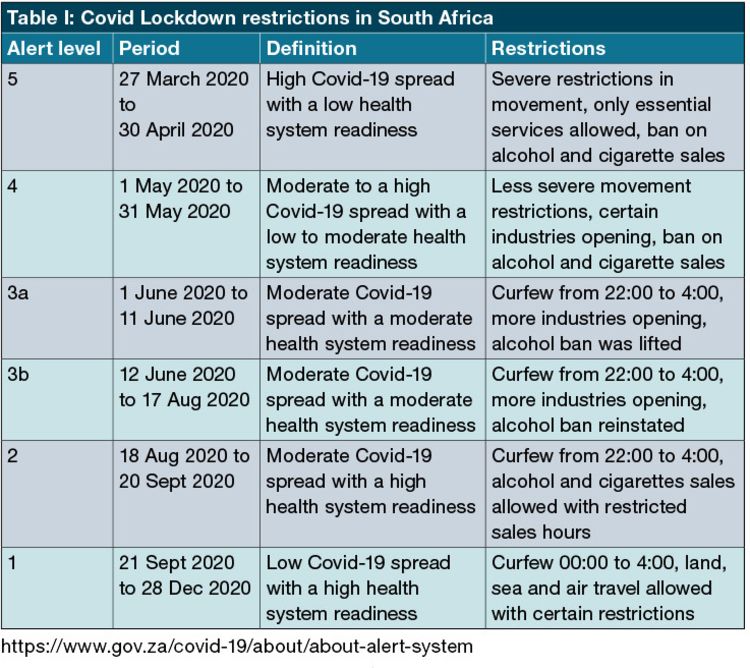
McCord Provincial Eye Hospital (MPEH) and Inkosi Albert Luthuli Central Hospital (IALCH) are academic hospitals in the Greater Durban area. These hospital offers services at provincial and tertiary levels and thus are responsible for ocular trauma surgery referrals serving approximately 3 442 0003 people.
A major part of trauma related eye injuries is considered to be a result of alcohol consumption/abuse, travel, work environment and social gatherings. It was widely speculated amongst healthcare workers that lockdown and the restrictions associated therewith would lead to a significant reduction in open globe injuries (OGI’s).
The hypothesis was that restrictions on alcohol sales would lead to a reduction in alcohol abuse. This would in turn significantly lower alcohol associated OGI’s. Another hypothesis was that the reduction in OGI’s will also take place because of the implementation of curfews and travel restrictions. On the other hand, forced confinement to a home environment and isolation of individuals and families from social and financial support, might increase cases of family and gender-based violence and socio-economic injury. We hypothesized that there would thus be a direct correlation to above mentioned restrictions to OGI numbers as well as changes in patterns of presentation.
Although Open Globe Injury (OGI) is a common presentation in hospitals worldwide, the epidemiology seems to vary substantially.
Methodology
This study is a retrospective observational descriptive study including all patients, irrespective of gender and age, presenting at McCord Provincial Eye Hospital (MPEH) and Inkosi Albert Luthuli Central Hospitals (IALCH) with open globe injuries (OGI’s). They are the two major referral hospitals in the eThekwini district in the coastal province of KwaZulu-Natal in South Africa.
Retrospective data was obtained by extracting patient information from theatre registers from both MPEH and IALCH. MPEH is still using physical paper-based files for record keeping and records were drawn from the filing room for evaluation on site. IALCH has an electronic health record system and retrieval of records was done by using the criteria presented to the IT team who extracted the data into a spreadsheet for ease of use. Intraoperative theatre notes were used to grade the injury using the Ocular Trauma Score (OTS).1
For this study, instruments used to analyse are limited to the Birmingham Eye Trauma Terminology (BETT)2, and the Ocular Trauma Score (OTS)1. The most prominent and widely used description of ocular trauma has traditionally been BETT but this was further expanded in the OTS which was developed to specifically assess OGI and provide prognostic evaluation. The OTS uses the Raw score seen in Table II, which is a numerical number given to determine the degree of severity of an OGI. A high Raw score implies a more favourable prognosis than a lower score.
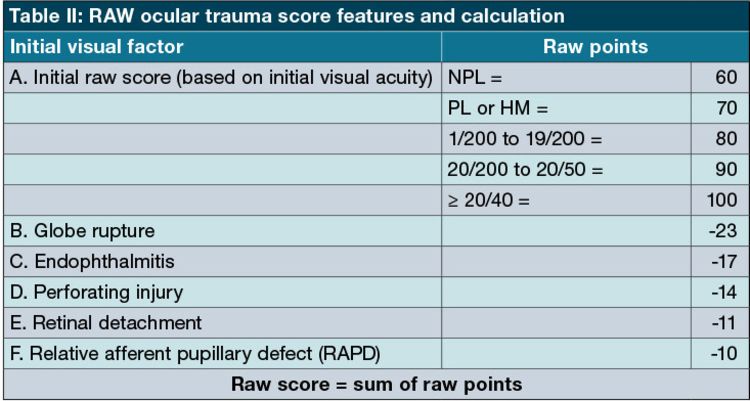
The Birmingham Eye Trauma Terminology4 defines an open globe injury as a full thickness wound of the eye wall. A rupture is a full thickness injury to the eye wall caused by a blunt object, while a laceration is defined as a full thickness wound caused by a sharp item. A penetrating injury is described as an injury where an entrance wound is present in the globe, while a perforating injury has both an entrance and exit wound.
Inclusion criteria for patient eligibility were as follows: any patient of any age and any gender presenting at MPEH or IALCH with an OGI in need of ocular surgery severe enough to warrant general anaesthesia. The period for the study were during the Covid-19 Lockdown, 27 March 2020 to 21 October 2020 (study cases) and the same dates but exactly one year earlier, 27 March 2019 to 21 October 2019 as the control group.
Patients were excluded from the study if they did not need surgical repair of their eyeball, or any open globe pathology caused by reasons other than trauma, for example perforations due to infections or malignancies.
Data collection was performed on site at MPEH using the theatre register for initial patient identification and then retrieving the files from the file-room for evaluation. At IALCH a digital search was done from the electronic medical records using search criteria including key words and from electronic registers of the specific theatre where all the eye trauma was treated. The data collection was done ensuring anonymity in accordance with the principles of the Declaration of Helsinki. This study received bioethics approval from the University of KwaZulu-Natal (BREC/00003104/2021) as well as hospital site consent.
Statistical analysis
Data were analysed with Jamovi® (Jamovi Project 1.6, R 4.0) to calculate appropriate summary statistics. Non-parametric paired sample t-tests were used to calculate reductions in injury numbers, severity, and other results. A p-value of <0.05 was considered statistically significant.
Results
As shown in Table III, a total of 143 open globe injuries (OGIs) were included in this study: 56 injuries during the Covid-19 lockdown period and 87 for the same time, but twelve months before the lockdown. During both periods, pre-pandemic and during the pandemic the vast majority of participants were of African descent (98% and 91% respectively (p = 0.28). The median age was 27 years pre-Covid and 28 years during lockdown, and lockdown had no influence in the male to female ratio of the incidence of OGI’s which remained at 5:1.
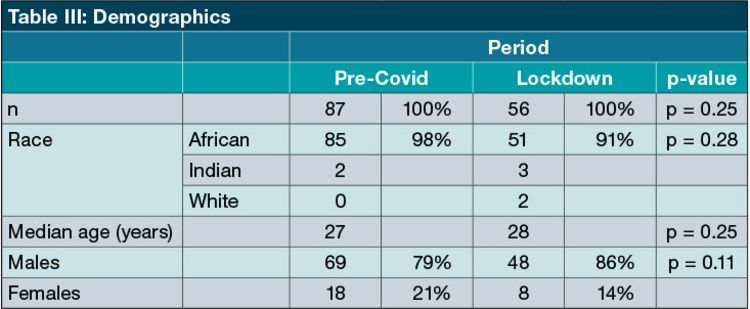
Only four of the eyes had an eye pathology preceding the injury, so the effect of prior ocular disease on injury severity outcome was not significant (p = 0.655). Before the pandemic, the mechanism of most open globe injuries was by laceration, followed by penetration, rupture and perforations, respectively. As shown in Figure 1, this trend persisted during the lockdown period (p = 0.088).
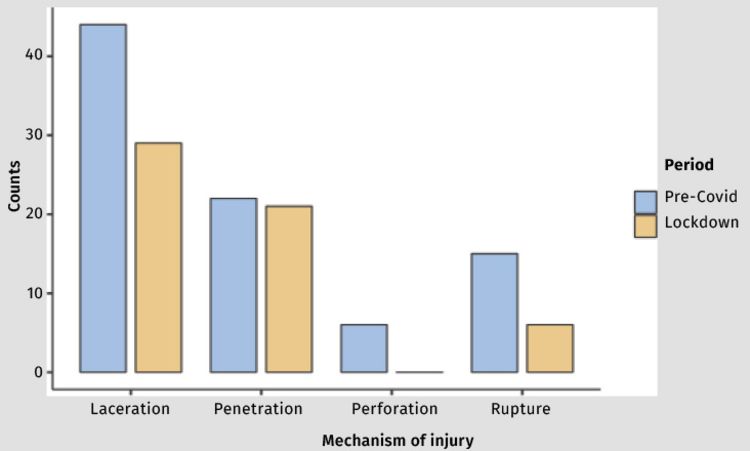
Figure 1: Injury mechanism classification
Figure 1: Injury mechanism classification
The physical locations where the injury occurred were also unchanged during lockdown (p = 0.16), mostly occurring at home in both cohorts (Figure 2).
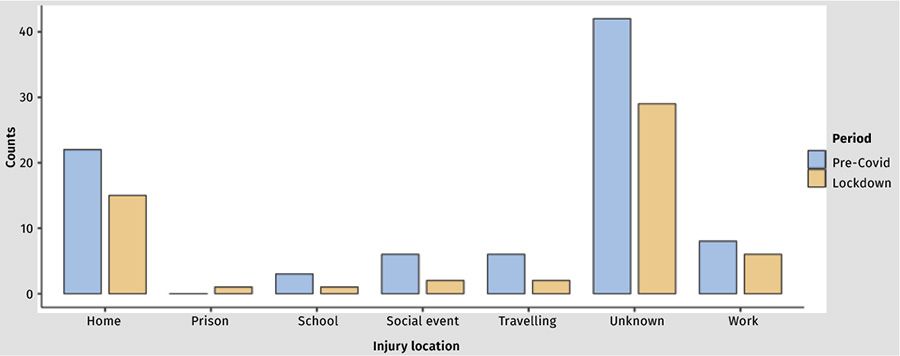
Figure 2: Physical location where the injuries occurred
Figure 2: Physical location where the injuries occurred
The total number of cases were not significantly different during lockdown (p = 0.250), but the median injury severity as indicated by the Raw score was slightly lower (Table IV: p = 0.038). There was, however, no significant difference in number or severity of injury when comparing the two lockdown groups, with and without alcohol restrictions (p = 0.078).

The number of patients who were intoxicated during injury were similar in both periods (P = 0.739). The surgical delay after injury was comparable, at four days before and three days during lockdown (p = 0.122) and had no bearing on the ocular trauma score.
Discussion
Studies in some countries show little correlation to alcohol abuse and OGI. In the city of Al-Ain in the Emirate of Abu Dhabi, a high-income but developing country, OGI was attributed mainly to occupational (50.4%) and home injuries (31.2%)5 The mechanisms of injury are mainly from sharp objects (24.1%) and blunt trauma (16.3%), with no association with alcohol use. In Hong Kong the three major reasons for OGI are workplace injuries (36%), followed by falls (32%) and assaults (13%). In Turkey, penetrating OGI in children between the ages of 0 and 15 year were mostly accidental during play, while work related injuries were most frequent between the ages of 16 and 60 years.
In developed countries the incidence of OGI is generally lower than in developing countries but still produces a noteworthy burden on visual impairment. In Australia, accidental falls were the most common cause of OGI in the elderly, while assault (often alcohol-related) and work-related injuries were more common in the younger age groups.
On the contrary an Australian study done in the far north Queensland health districts concluded that there was a disproportionately high incidence of OGI associated with alcohol abuse, especially amongst the Aboriginal and Torres Strait Islander population. Several other studies showed that type and extent of ocular injury due to alcohol use by either the assailant or the injured was similar.
A strong relationship between alcohol use and OGI was also determined in South Africa by a study done at Groote Schuur Hospital where 66.1% of the victims sustaining an OGI admitted to using alcohol immediately prior to the injury. Assault had occurred in 73.5% of these cases and only 26.5% of these OGIs were claimed to have been accidental.
These findings supported the prediction that a ban on alcohol sales such as implemented in South Africa could result in a reduction in the presentation of OGI’s to hospitals such as MPEH and IALCH. The most recent study published by Dorman et al. indicates a reduction in OGI in their population where alcohol management plans were implemented.
An initial study by Pellegrini et al. looked at all ocular trauma presenting to an Italian ophthalmology emergency unit during Covid-19 lockdown periods found a significant reduction in all types of ocular trauma during the pandemic. The author reasoned that these results could also be attributed to patients avoiding seeking help to reduce exposure to the SARS-CoV-2 virus. In contrast to our referral eye services, the Italian unit accepts relatively minor ocular trauma and severe eye trauma would probably preclude patients from opting to avoid medical care. A follow up study by Pelligrini et al.15 further indicated a significant reduction in admissions due to ocular trauma. Surgery related conditions like retinal detachments were also reduced from 22 in 2019 to 11 during the Covid-19 period.
One of the main reasons given by the National Coronavirus Command Council for the strict lockdown periods from 27 March to 21 October 2020, was to reduce the amount of trauma presenting to health facilities in order to facilitate shifting of medical resources to patients with Covid-19. In the Durban Ophthalmology Complex, the total number of open globe injuries (OGIs) was expected to decrease substantially. Several health care workers at IALCH and MPEH were redeployed to assist facilities dedicated to the treatment of Covid-19 and its complications.
The total number of OGIs in our study did not decrease significantly, although the severity of these injuries (Raw score) was less than before Covid lockdown, these changes were only moderate. The median OTS score remained at 2 if calculated from the Raw score in both groups. Contrary to our study, Vural et al.16 found in Turkey no change in the severity of the OGI’s according to the OTS. They did however mention an increase in OGI’s referred to their hospital due to the restriction countrywide put on secondary hospitals to reduce surgery. The study from You-Mei Xu et al.17 from China indicated a significant increase in the number of open-globe injuries and a significant increase in the severity if the injuries sustained but an overall decrease in ocular trauma patients.
A large part of the lockdown included a ban on travelling, attending school, social events, and non-essential employment, it was also reasonable to expect other variances between the two periods. Changes in demographic results were also expected as more men than women are employed in South Africa18 so a decrease in male work-related accidents was expected. In Korea Woong-Joo Whang19 found a significant decrease in male and increase in female incidences but in our setting we had no changes in the male to female injury ratio. A possible increase in gender-based violence at home were also expected as suggested by Huiyu Liang et al. 20. In this study, location of injury and gender showed no differences between before and during the lockdowns.
Contrary to this study, Stedman et al.21 found a three times increase in serious ocular trauma cases during the Covid-19 pandemic than in the previous five years leading up to it. This was attributed to more DIY being done at home. It also showed a delay in presentation to hospitals for care suggesting a reluctance to seek medical support during the pandemic.
The shortcoming of this study is that it only included 143 patients. Increasing the study cohort to include more eye centres in South Africa might have shown more significant results. Despite the expectations and intentions of the lockdown during the Covid-19 pandemic in South Africa, a major reduction in open globe trauma was not realised.
The importance of knowing the impact of a global pandemic on health services in our developing country with its unique setting can assist in planning and reducing the impact of future outbreaks on the health system.
Conclusion
A total of 143 open globe injuries from public eye hospitals in a middle-income country were analysed in this study. Results showed that during lockdown the total number of open globe injuries did not decrease significantly but the median severity of the injuries decreased slightly from 47 (worse prognosis) to 56 (slightly better prognosis) as measured by Raw score. All other variables including age, sex, race, mechanism of injury, alcohol intoxication and physical location where the trauma occurred, remained unchanged.
References
- Kuhn F, Maisiak R, Mann L, Mester V, Morris R, Witherspoon CD. The Ocular Trauma Score (OTS). Ophthalmol Clin North Am. 2002;15(2):163-5, vi.
- Kuhn F, Morris R, Witherspoon CD, Mester V. The Birmingham Eye Trauma Terminology system (BETT). J Fr Ophtalmol. 2004;27(2):206-10.
- Statistics South Africa. Local Municipality | Statistics South Africa [Internet]. Statssa.gov.za. 2015. Available from: https://www.statssa.gov.za/?page_id=993&id=ethekwini-municipality.
- Kuhn F, Morris R, Witherspoon CD, Mester V. The Birmingham Eye Trauma Terminology system (BETT). J Fr Ophtalmol. 2004;27(2):206-10.
- AlMahmoud T, Al Hadhrami SM, Elhanan M, Alshamsi HN, Abu-Zidan FM. Epidemiology of eye injuries in a high-income developing country: An observational study. Medicine (Baltimore). 2019;98(26):e16083.
- Li EY, Chan TC, Liu AT, Yuen HK. Epidemiology of Open-Globe Injuries in Hong Kong. Asia Pac J Ophthalmol (Phila). 2017;6(1):54-8.
- Cakmak SS, Unlu MK, Olmez G, Caca I, Sakalar YB, Acemoglu H. Penetrating eye injuries from southeastern Anatolia region of Turkey. Public Health. 2004;118(8):570-5.
- Beshay N, Keay L, Dunn H, Kamalden TA, Hoskin AK, Watson SL. The epidemiology of Open Globe Injuries presenting to a tertiary referral eye hospital in Australia. Injury. 2017;48(7):1348-54.
- Smith AR, O’Hagan SB, Gole GA. Epidemiology of open- and closed-globe trauma presenting to Cairns Base Hospital, Queensland. Clin Exp Ophthalmol. 2006;34(3):252-9.
- Kennedy MS, Robinson J, Whist E, McCallum GB, Mahendrarajah T. Epidemiology of ocular trauma in the Indigenous vs non-Indigenous population in the Top End. Clin Exp Ophthalmol. 2019;47(8):995-9.
- Rüfer F, Peters A, Klettner A, Treumer F, Roider J. Influence of alcohol consumption on incidence and severity of open-globe eye injuries in adults. Graefes Arch Clin Exp Ophthalmol. 2011;249(12):1765-70.
- du Toit N, Mustak H, Levetan C, Cook C. Open globe injuries in patients seen at Groote Schuur Hospital, Cape Town, South Africa. S Afr J Surg. 2013;51(3):97-101.
- Dorman A, O’Hagan S, Gole G. Epidemiology of severe ocular trauma following the implementation of alcohol restrictions in Far North Queensland. Clin Exp Ophthalmol. 2020.
- Pellegrini M, Roda M, Di Geronimo N, Lupardi E, Giannaccare G, Schiavi C. Changing trends of ocular trauma in the time of COVID-19 pandemic. Eye (Lond). 2020;34(7):1248-50.
- Pellegrini M, Roda M, Lupardi E, Di Geronimo N, Giannaccare G, Schiavi C. The impact of COVID-19 pandemic on ophthalmological emergency department visits. Acta Ophthalmol. 2020;98(8):e1058-e9.
- Sahin Vural G, Yilmaz S, Karahan E, Guler C. A Comparative Evaluation of Globe Trauma Features in a Tertiary Care Hospital Before and During the COVID-19 Pandemic. Turk J Ophthalmol. 2022;52(2):102-8.
- Xu YM, Du LP, Huo YD, An GQ, Jin XM, Zhou PY. COVID-19 pandemic impact on ocular trauma in a tertiary hospital. Int J Ophthalmol. 2023;16(1):16-21.
Copyright © 2022 [Dr PJ Snyman and Dr CH Kruse].
All rights reserved. Copyright subsists in the Author of this work. No part of this article or included photographs may be reproduced, published, performed, broadcast, transmitted or adapted in any form or by any electronic, mechanical, or other means without the written permission of the copyright holder. This article is published by New Media, a division of Media24 (Pty) Ltd with consent of the Author. Any unauthorised reproduction, publishing, or adaption of this work will constitute copyright infringement and render the doer liable under both civil and criminal law.
